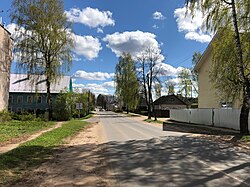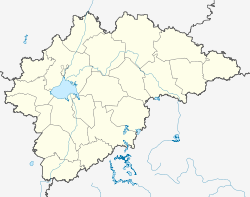Demyansk (Russian: Демя́нск) is an urban locality (a work settlement) and the administrative center of Demyansky District of Novgorod Oblast, Russia, located along the Yavon River. Municipally, it is incorporated as Demyanskoye Urban Settlement, the only urban settlement in the district. Population: 5,365 (2010 Census);[4] 5,825 (2002 Census);[8] 5,999 (1989 Soviet census).[9]
Demyansk
Демянск | |
|---|---|
 Demyansk | |
| Coordinates: 57°39′N 32°28′E / 57.650°N 32.467°E | |
| Country | Russia |
| Federal subject | Novgorod Oblast |
| Administrative district | Demyansky District[1] |
| First mentioned | 1406[2] |
| Urban-type settlement status since | December 28, 1960[3] |
| Population | |
• Total | 5,365 |
| • Capital of | Demyansky District[1] |
| • Municipal district | Demyansky Municipal District[5] |
| • Urban settlement | Demyanskoye Urban Settlement[5] |
| • Capital of | Demyansky Municipal District, Demyanskoye Urban Settlement[5] |
| Time zone | UTC+3 (MSK |
| Postal code(s)[7] | |
| OKTMO ID | 49612151051 |
History
editDemyansk was first mentioned in a chronicle in 1406 as Demon. The area was a part of Derevskaya Pyatina of Novgorod.[2] Demon was a fortress protecting a waterway from Lake Ilmen upstream the Pola and the Yavon to Lake Seliger. The fortress was located close to the boundary between the Novgorod Republic and the Grand Duchy of Moscow, and it was at least twice sieged by Muscovite troops. In 1441, the Muscovites did not manage to conquer Demon, but in the 1470s they conquered and destroyed the fortress. After the subsequent fall of Novgorod, Demon was transferred to the Grand Duchy of Moscow. In the 17th century, Demon went into decline, and a new settlement was founded nearby, which was known as Demyansky Pogost, and later as Demyansk. In the course of the administrative reform carried out in 1708 by Peter the Great, the area was included into Ingermanland Governorate (known since 1710 as Saint Petersburg Governorate). In 1727, separate Novgorod Governorate was split off. Between 1772 and 1824, Demyansk was a part of Starorussky Uyezd of Novgorod Viceroyalty (since 1796 of Novgorod Governorate). In 1824, it was chartered and became the center of Demyansky Uyezd, which was split off Starorussky Uyezd.[10]
On August 1, 1927, the uyezds were abolished, and Demyansky District was established, with the center in Demyansk. Demyansk belonged to Novgorod Okrug of Leningrad Oblast. Effective October 1, 1927 the town of Demyansk was made a selo. On July 23, 1930 the okrugs were abolished, and the districts became directly subordinate to the oblast. Between September, 1941, and February, 1943 parts of Demyansk District were occupied by German troops. The settlement was a place for the Battle of Demyansk during World War II in 1942. On July 5, 1944, Demyansky District was transferred to newly established Novgorod Oblast and remained there ever since. On December 28, 1960 Demyansk was granted the urban-type settlement status.[3]
Economy
editIndustry
editThe existing enterprises in Demyansk serve timber and food industries.[2]
Transportation
editDemyansk is located on the road connecting Yazhelbitsy and Staraya Russa. There are also local roads. There is bus traffic originating from Demyansk.
Culture and recreation
editDemyansk contains thirteen objects classified as cultural and historical heritage of local significance.[11] These include a number of pre-1917 buildings of the former uyezd center, including a prison, an archaeological monument, and a number of graves of soldiers fallen in World War II.
Demyansk hosts the Demyansky District Museum.[2]
References
editNotes
edit- ^ a b c Law #559-OZ
- ^ a b c d Историческая справка (in Russian). Официальный сайт Администрации Демянского муниципального района. 2012. Archived from the original on March 4, 2016. Retrieved February 15, 2012.
- ^ a b Снытко, О.В.; et al. (2009). С.Д. Трифонов; Т.Б. Чуйкова; Л.В. Федина; А.Э. Дубоносова (eds.). Административно-территориальное деление Новгородской губернии и области 1727-1995 гг. Справочник (PDF) (in Russian). Saint Petersburg. p. 101. Retrieved February 15, 2012.
{{cite book}}: CS1 maint: location missing publisher (link) - ^ a b Russian Federal State Statistics Service (2011). Всероссийская перепись населения 2010 года. Том 1 [2010 All-Russian Population Census, vol. 1]. Всероссийская перепись населения 2010 года [2010 All-Russia Population Census] (in Russian). Federal State Statistics Service.
- ^ a b c Law #397-OZ
- ^ "Об исчислении времени". Официальный интернет-портал правовой информации (in Russian). June 3, 2011. Retrieved January 19, 2019.
- ^ Почта России. Информационно-вычислительный центр ОАСУ РПО. (Russian Post). Поиск объектов почтовой связи (Postal Objects Search) (in Russian)
- ^ Federal State Statistics Service (May 21, 2004). Численность населения России, субъектов Российской Федерации в составе федеральных округов, районов, городских поселений, сельских населённых пунктов – районных центров и сельских населённых пунктов с населением 3 тысячи и более человек [Population of Russia, Its Federal Districts, Federal Subjects, Districts, Urban Localities, Rural Localities—Administrative Centers, and Rural Localities with Population of Over 3,000] (XLS). Всероссийская перепись населения 2002 года [All-Russia Population Census of 2002] (in Russian).
- ^ Всесоюзная перепись населения 1989 г. Численность наличного населения союзных и автономных республик, автономных областей и округов, краёв, областей, районов, городских поселений и сёл-райцентров [All Union Population Census of 1989: Present Population of Union and Autonomous Republics, Autonomous Oblasts and Okrugs, Krais, Oblasts, Districts, Urban Settlements, and Villages Serving as District Administrative Centers]. Всесоюзная перепись населения 1989 года [All-Union Population Census of 1989] (in Russian). Институт демографии Национального исследовательского университета: Высшая школа экономики [Institute of Demography at the National Research University: Higher School of Economics]. 1989 – via Demoscope Weekly.
- ^ Снытко, О.В.; et al. (2009). С.Д. Трифонов; Т.Б. Чуйкова; Л.В. Федина; А.Э. Дубоносова (eds.). Административно-территориальное деление Новгородской губернии и области 1727-1995 гг. Справочник (PDF) (in Russian). Saint Petersburg. p. 59. Retrieved February 15, 2012.
{{cite book}}: CS1 maint: location missing publisher (link) - ^ Памятники истории и культуры народов Российской Федерации (in Russian). Russian Ministry of Culture. Retrieved June 2, 2016.
Sources
edit- Новгородская областная Дума. Областной закон №559-ОЗ от 11 ноября 2005 г. «Об административно-территориальном устройстве Новгородской области», в ред. Областного закона №730-ОЗ от 26 февраля 2015 г. «О внесении изменений в Областной закон "Об административно-территориальном устройстве Новгородской области"». Вступил в силу 1 января 2006 г. Опубликован: "Новгородские ведомости", №75, 23 ноября 2005 г. (Novgorod Oblast Duma. Oblast Law #559-OZ of November 11, 2005 On the Administrative-Territorial Structure of Novgorod Oblast, as amended by the Oblast Law #730-OZ of February 26, 2015 On Amending the Oblast Law "On the Administrative-Territorial Structure of Novgorod Oblast". Effective as of January 1, 2006.).
- Администрация Новгородской области. Постановление №121 от 8 апреля 2008 г. «Об реестре административно-территориального устройства области», в ред. Постановления №408 от 4 августа 2014 г. «О внесении изменений в реестр административно-территориального устройства области». Опубликован: "Новгородские ведомости", №49–50, 16 апреля 2008 г. (Administration of Novgorod Oblast. Resolution #121 of April 8, 2008 On the Registry of the Administrative-Territorial Structure of Novgorod Oblast, as amended by the Resolution #408 of August 4, 2014 On Amending the Registry of the Administrative-Territorial Structure of Novgorod Oblast. ).
- Новгородская областная Дума. Областной закон №397-ОЗ от 17 января 2005 г. «Об установлении границ муниципальных образований, входящих в состав территории Демянского муниципального района, наделении их статусом городского и сельских поселений, определении административных центров и перечня населённых пунктов, входящих в состав территорий поселений», в ред. Областного закона №216-ОЗ от 1 марта 2013 г. «О внесении изменений в некоторые областные законы, содержащие перечни населённых пунктов, входящих в состав территорий поселений». Вступил в силу со дня, следующего за днём официального опубликования. Опубликован: "Новгородские ведомости", №11–12, 26 января 2005 г. (Novgorod Oblast Duma. Oblast Law #397-OZ of January 17, 2005 On Establishing the Borders of the Municipal Formations Within the Territory of Demyansky Municipal District, on Granting Them the Status of Urban and Rural Settlements, on Establishing Their Administrative Centers, and on Compiling the Lists of Inhabited Localities Within the Settlement Territories, as amended by the Oblast Law #216-OZ of March 1, 2013 On Amending Various Oblast Laws Containing the Lists of Inhabited Localities Within the Settlement Territories. Effective as of the day following the day of the official publication.).



